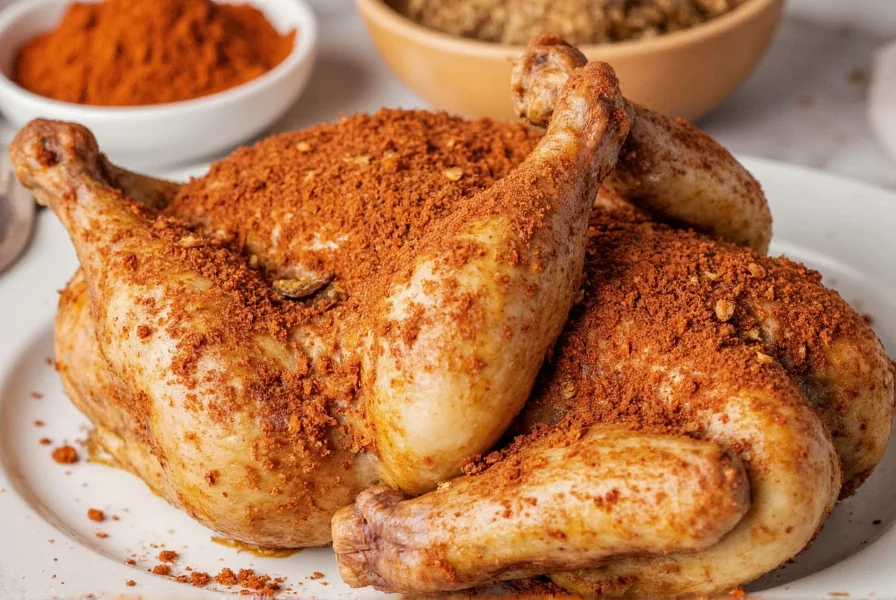Table of Contents
Introduction to Roast Chicken Spice Rub
The perfect roast chicken spice rub combines six essential spices that transform ordinary chicken into a flavorful masterpiece. This guide provides exact measurements, expert application techniques, and science-backed insights to achieve crispy skin and juicy meat every time. Whether you're a beginner or experienced cook, these proven methods will elevate your roast chicken game.
Essential Spices for a Perfect Rub
Based on professional chef recommendations and flavor science, these six spices create the ideal balance for roast chicken:
- Paprika (2 tsp): Provides sweet smokiness and vibrant color. Use smoked paprika for deeper flavor.
- Garlic Powder (1.5 tsp): Delivers savory depth without burning. Essential for umami development.
- Onion Powder (1.5 tsp): Enhances natural sweetness and creates complex crust formation.
- Cumin (1 tsp): Adds warm earthiness that complements chicken's natural fats.
- Oregano (1 tsp): Offers herbal brightness that cuts through richness.
- Salt & Pepper (2 tsp salt, 1 tsp black pepper): The foundational pair that unlocks all other flavors.
Pro Tip: Always measure spices by weight for precision. For a 4-5lb chicken, use these exact ratios to avoid overpowering any single flavor.
Practical Tips for Applying the Rub
Follow these scientifically-backed steps for maximum flavor penetration and crispy skin:
- Dry brine first: Pat chicken completely dry, then rub with 1 tsp salt and refrigerate uncovered for 12-24 hours. This draws out moisture for crispier skin.
- Apply oil first: Lightly coat skin with 1 tbsp neutral oil (like avocado) before applying rub. This helps spices adhere and promotes even browning.
- Massage under skin: Gently lift skin from breast and thighs, then rub spices directly onto meat for deeper flavor infusion.
- Rest properly: Let chicken sit at room temperature for 45 minutes after applying rub. This allows flavors to penetrate and prevents temperature shock during cooking.
- Optimal cooking temp: Roast at 425°F (220°C) for first 30 minutes to crisp skin, then reduce to 375°F (190°C) for even cooking.
| Spice Blend Type | Best For | Key Characteristics | Professional Use Case |
|---|---|---|---|
| Classic American | Weeknight dinners | Balanced paprika, garlic, onion with herbs | Thanksgiving roasts, family gatherings |
| Mediterranean | Summer grilling | Lemon zest, oregano, rosemary dominant | Outdoor barbecues, Mediterranean-themed meals |
| Smoky Southwest | Barbecue events | Chipotle, cumin, chili powder focus | Backyard cookouts, tailgating parties |
| Herb-Forward | Health-conscious cooking | Thyme, rosemary, sage dominant | Dietary-restricted meals, gourmet presentations |

Frequently Asked Questions
How long should I let the spice rub sit on chicken before cooking?
For optimal flavor penetration, allow the spice rub to sit on your chicken for at least 45 minutes at room temperature. For deeper flavor infusion, dry brine with salt 12-24 hours before applying the full rub. This process draws out moisture for crispier skin while allowing spices to penetrate the meat.
Can I use fresh herbs instead of dried spices in my rub?
While dried spices work best for traditional rubs (fresh herbs contain moisture that prevents proper browning), you can incorporate fresh herbs in two ways: 1) Mix finely minced fresh herbs with oil to create a paste applied under the skin, or 2) Tuck whole sprigs between skin and meat. For surface rubs, always use dried herbs to maintain crispiness.
What's the difference between a spice rub and a marinade for chicken?
A spice rub creates a flavorful crust on the surface while a marinade tenderizes through acid. Rubs work faster (30-60 minutes) and are ideal for crispy skin, while marinades require 2+ hours and are better for tougher cuts. For best results, use rubs for whole chickens and marinades for chicken thighs or breasts.
How much rub should I use per pound of chicken?
Use 1.5 teaspoons of total rub per pound of chicken. For a standard 4-5lb bird, this equals 6-7.5 teaspoons total. Apply 2/3 on the skin surface and 1/3 under the skin for maximum flavor distribution. Avoid thick clumps that could burn during cooking.
Can I make the spice rub ahead of time and store it?
Yes! Store homemade rub in an airtight glass container away from light and heat. Properly stored, it maintains peak potency for 6 months. For best results, make in small batches (enough for 2-3 uses) and always measure spices by weight for consistency. Never store in plastic containers as they absorb spice oils.
Conclusion
Mastering roast chicken spice rubs requires precision, not guesswork. By using exact measurements, proper application techniques, and understanding how each spice interacts with chicken's natural fats, you'll consistently achieve restaurant-quality results. Remember: the difference between good and great roast chicken lies in the details - from dry brining to precise spice ratios. Start with this proven formula, then experiment with variations to make it your own.










 浙公网安备
33010002000092号
浙公网安备
33010002000092号 浙B2-20120091-4
浙B2-20120091-4